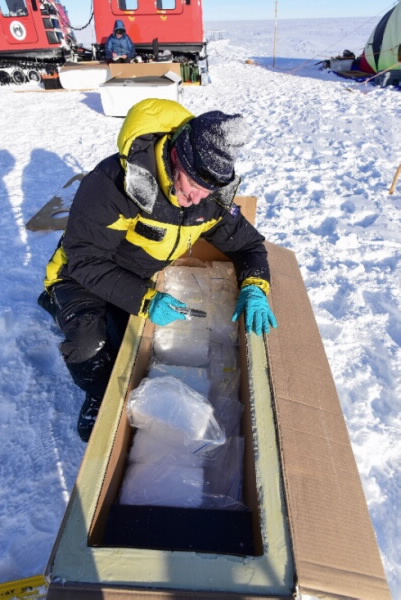 |
| Dr Andrew Smith checks samples prior to transport to Australia. Photo credit: Gordon Tait. |
Institute for Environmental research scientist Dr Andrew Smith is quite used to the frigid temperatures experienced during his expeditions to polar locations. Andrew has just finished collecting ice cores and snow samples on the summit of Law Dome in Antarctica, assisted by CSIRO scientist Dr David Etheridge and support staff from nearby Casey Station.
Beryllium-7 has a very short half-life of 53 days, the air link from Antarctica to Hobart is important.
“This allows us to rapidly return the samples to Australia, process and get them in to the accelerator quickly for measurement before the signal weakens,” explained Smith.
“This allows us to rapidly return the samples to Australia, process and get them in to the accelerator quickly for measurement before the signal weakens,” explained Smith.
Scientists are interested in isotopes of beryllium because they can provide information about solar activity over long periods of time, well before the sunspot record. An understanding of how solar activity has changed is important for past climate change studies and also to understand the behaviour of the Sun.
The samples are headed to ANSTO for measurement on the ANTARES particle accelerator , which can detect the individual beryllium-10 and beryllium-7 atoms by the technique of accelerator mass spectrometry. The rates of radioactive decay are different for the two isotopes and can be used as a ‘clock’ to determine the age of air masses.
Cosmogenic beryllium atoms are formed by cosmic rays smashing oxygen and nitrogen nuclei into smaller fragments. They are captured by aerosol particles and are eventually transported to the Antarctic continent and trapped in ice crystals in the atmosphere.
The ice crystals tumble down to the summit of the Law Dome, a small ice cap on the edges of the main East Antarctic ice sheet. Because polar ice sheets are annually layered scientists can tell when the beryllium reached the ground.
“Law Dome has an elevation of 1,400m with 1,200m of that pure ice holding an important record of the past. It is an ideal place for such studies and was a balmy -20 °C during my trip,” said Smith.
This year Andrew’s field work had an unexpected variation following a rare sub-glacial water eruption 15 kilometres from Australia’s Casey Station on the Law Dome.
A sudden outburst of basal meltwater from beneath the ice cap, a Jökulhlaup, is an unusual occurrence. Winter expeditioners from Casey noticed it flowing early last year.
By the time Andrew and his team arrived it had ceased flowing and was frozen, however they were able to take samples of this ice.
The next step is to determine just how old this water was, using isotopes of water. The samples may help explain why meltwater is present and the extent of the river and dam systems deep under the ice cap.
Smith’s blog while undertaking field work in Greenland in 2013 and earlier blogs from Antarctica attracted considerable interest from the scientific community and the public.


